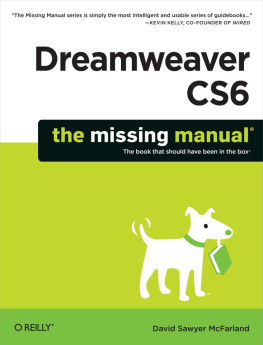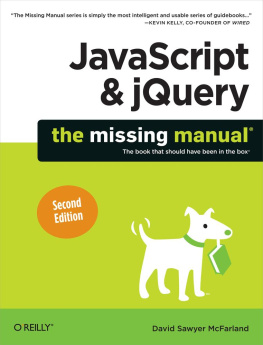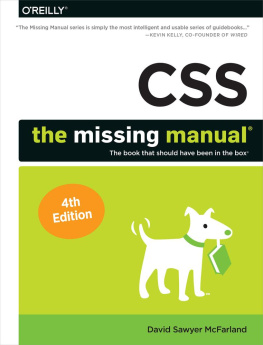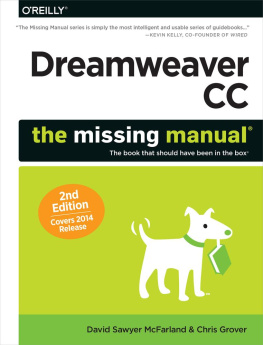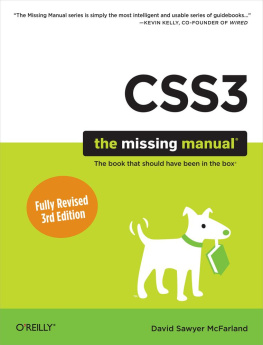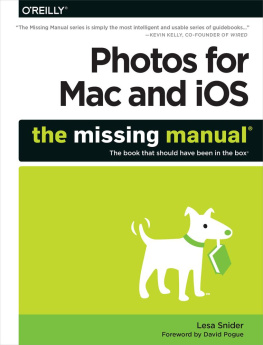About the Author
David Sawyer McFarland is president of Sawyer McFarland Media, Inc., a Web development and training company in Portland, Oregon. He's been building Web sites since 1995, when he designed his first website: an online magazine for communication professionals. He's served as the Webmaster at the University of California at Berkeley and the Berkeley Multimedia Research Center, and he has helped build, design, and program numerous websites for clients including Macworld.com, among others.
In addition to building websites, David is also a writer, trainer, and instructor. He's taught Web design at the UC Berkeley Graduate School of Journalism, the Center for Electronic Art, the Academy of Art College, and the Art Institute of Portland. He currently teaches in the Multimedia Program at Portland State University. He's written articles about Web design for Practical Web Design, Macworld magazine and CreativePro.com.
David is also the author of CSS: The Missing Manual, and JavaScript: The Missing Manual. He welcomes feedback about this book by email: .)
About the Creative Team
Peter McKie (editor) is an editor at Missing Manuals. He graduated with a master's degree from Boston University's School of Journalism and lives in New York City, where he researches the history of old houses and, every once in a while, sneaks into abandoned buildings. Email: .
Adam Zaremba (production editor) recently received his M.A. from the Editorial Institute at Boston University. He lives in Chestnut Hill, Mass., and does, in fact, like green eggs and ham.
Nancy Reinhardt (copy editor) is a freelance copy editor living in the Midwest who enjoys swimming, biking, and history. She is an avid reader and writer of romance novels and is currently shopping her first book. Email: .
Julie Hawks (indexer) is an indexer for the Missing Manual series. Her other life includes photography, tinkering with databases, and enjoying nature. Email: .
Murray R. Summers (technical reviewer) is an Adobe Certified Web Site Developer, Dreamweaver Developer, and Community Professional, and has co-authored a book on Dreamweaver templates and contributed chapters to several books on Dreamweaver. His company, Great Web Sights, has been active in web development since 1998. Murray lives in rural Philadelphia with his wife Suzanne. His daughter, Carly, is currently attending Clemson University (go Tigers!).
John C. Bland II (technical reviewer) is the founder of Katapult Media, Inc., which focuses on software and web development using technologies like ColdFusion, Flash, PHP, Java, the .NET Platform, and Objective-C (iPhone OS, Mac OS X, and so on). He is a co-author of ColdFusion Web Application Framework and Flex 4 in Action. An Adobe Community Professional, John continues to contribute to the community that helped mold him into the developer he is today. John blogs regularly on his blog at www.johncblandii.com.
Acknowledgements
Many thanks to all those who helped with this book, including Deb Pang Davis, the design mastermind behind ChiaVet.com, and my technical editors, Murray Summers and John Bland, whose critiques have provided a comfortable safety net to protect me from any embarrassing gaffes. Thanks also to my students, who've helped me understand Dreamweaver better and always seem to come up with at least one question that I have no answer for.
Finally, thanks to Peter McKie, whose strong editing hand has helped make my writing more active and accurate; to my wife, Scholle, for being such a strong supporter of my writing and a wonderful partner in my life; my mom and Doug; Mary, David, Marisa, and Tessa; Phyllis and Les; my son, Graham, who has taught me that robots, spaceships, Star Wars, and Legos are much more important than writing books; and to my daughter, Kate, who would have been much happier if I wrote a book about Elmo, Big Bird, and Cookie Monster.
Dave McFarland
Introduction
Websites continue to evolve, growing in scope and complexity every year, with new features popping up to make the Web look and work better. Even people building personal websites use various programming languages and server technologies to dish up content. Throughout its history, Dreamweaver has managed to keep pace with this changing landscape.
Dreamweaver CS5 is no exception: It's capable of doing more than any previous version. Whether you're creating database-enabled PHP pages, using Cascading Style Sheets (CSS) for cutting-edge design effects, dipping into the dynamic world of JavaScript and AJAX, or simply sticking to straightforward HTML pages, Dreamweaver has just about all the tools you need.
Any enterprising designer can create web pages, Cascading Style Sheets, and even JavaScript programs with a simple text editor. In fact, Dreamweaver CS5 provides a powerful text editor that lets you handcraft basic text files or complex database-driven pages. But why go to all that trouble when Dreamweaver's visual page-building approach, where you use friendly buttons, dialog boxes, and panels to create a web page, and let Dreamweaver tackle the hard chore of writing the underlying HTML code, makes creating beautiful and complex websites so much easier? Whether you're new to building web pages or a hard-core, hand-coding HTML jockey, Dreamweaver is a powerful tool that lets you build websites quickly and efficiently, without compromising the quality of your code.
What Dreamweaver Is All About
Dreamweaver is a complete website development and management program. It works with web technologies like HTML, XHTML, CSS, JavaScript, and PHP.
Dreamweaver's Cascading Style Sheet support lets you create fast-loading, easily modified page designs, while its unique "Spry" technology provides one-click access to complex, interactive layout options like drop-down menus.
Dreamweaver also includes plenty of tools for managing websites once you build them. You can check for broken links, use templates to streamline site-wide page changes, and reorganize your site in a flash with the program's site management tools.


